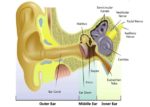The human skull, a marvel of biological engineering, serves as the body’s command center by housing the brain and forming the structure of the face. It consists of 22 bones, divided into two main parts: the cranium (or neurocranium) and the facial skeleton (or viscerocranium).
Cranium
The cranium, which encloses and protects the brain, is composed of eight bones:
1. Frontal Bone: Forms the forehead and the roofs of the eye sockets (orbits).
2. Parietal Bones (2): Form the sides and roof of the cranium.
3. Temporal Bones (2): Form the lower sides of the cranium and part of the cranial floor.
4. Occipital Bone: Forms the rear and base of the cranium.
5. Sphenoid Bone: Forms part of the base of the skull, the sides of the skull, and the floors and sides of the orbits.
6. Ethmoid Bone: Contributes to the walls of the orbits, the roof and walls of the nasal cavity, and the nasal septum.
Facial Skeleton
The facial skeleton comprises 14 bones:
1. Maxillae (2): The upper jaw bones also form the lower orbit and palate.
2. Palatine Bones (2): Form the posterior part of the hard palate and the floor of the nasal cavity.
3. Zygomatic Bones (2): The cheekbones also form the lateral part of the orbits.
4. Lacrimal Bones (2): The smallest bones of the face, located in the medial wall of the orbit.
5. Nasal Bones (2): Form the bridge of the nose.
6. Inferior Nasal Conchae (2): Form part of the lateral walls of the nasal cavity.
7. Vomer: Forms the inferior and posterior parts of the nasal septum.
8. Mandible: The lower jaw bone, the only moveable bone of the skull.
The skull also contains several sutures, which are joints that hold the bones together. The most significant are the coronal suture (between the frontal and parietal bones), the sagittal suture (between the parietal bones), and the lambdoidal suture (between the occipital and parietal bones).
The skull is not just a protective shell for the brain; it also contains several openings, called



